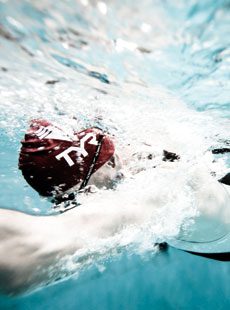Getting Started with Triathlon Swimming
Swimming is a sport where technical fundamentals are essential for any level of success.

Swimming is a sport very similar to cross country skiing, where a solid grasp of the technical fundamentals is essential for any level of success. Technique can take you much further towards mastering the sport than your physical conditioning ever will because of the dynamics of battling water to create forward motion.
One of the challenges in learning to swim is the lack of visual cues while you are engaged in the sport. What you think you are doing while you are swimming is often vastly different from what you are actually doing. Hand, hip, elbow and torso proprioception allows us to properly catch and release the water in an efficient manner, but this “feel” for the water is hard to ingrain when you haven’t started as a child. How can you connect your mind to your body in order to swim more efficiently? Here are some tips on how to approach your swim training:
1. Use a coach
Having someone on deck giving you instant feedback as you attempt to improve your swim stroke is enormously helpful. If you have no idea how to swim freestyle (front crawl) effectively, you will get your money’s worth to hire a one on one swim coach to look at you. Practicing bad technique from now until eternity may not make you much faster at all, which can be frustrating.
2. Employ video
Even the best on deck coaches sometimes can’t break through the brain/body barrier and really get you to understand what changes they are trying to make to your stroke. Looking at yourself on video and comparing that to what you think you look like: priceless. Even small changes in stroke technique feel like giant variations at first, so using video for feedback will help you to see just where you need to go.
3. Frequency
Swimming is a “feel” sport where you need to have good proprioception between your hands and the water. The more often you are in the water, the better your “feel” will become. If you only swim once or twice a week, you will lose that feel when you get back in the water. There is a continuum of good feel for the water that starts at its worst, when you have spaghetti arms and no feel at all, to its best, when you feel strong, powerful and in control of a lot of water. The more often you get your butt to the pool, the better your chances that you will feel strong and powerful.
4. Volume
I recognize this is advice can be controversial. I believe that any amateur triathlete’s swimming will improve if they swim more, period. I also think a lot of swimming benefits athletes no matter how important swim improvement is as the cardiovascular and core strength training are beneficial across the spectrum of disciplines in triathlon. Therefore, I think most athletes should strive to increase their swim volume if they would like to be better at triathlon in general.
When increasing the volume of swimming you are doing, I would first swim more times per week at the same mileage per workout. Keeping the daily session to a manageable volume and repeating that more often will lead to improvement. Over time you can then strive to increase the volume of the workout you are doing and the quality of the work within that workout.
5. Core
Swimming well involves core engagement to connect the hand and elbow to the torso to properly catch water. The rotator cuff needs to be strong to hold that water, but really you are pulling with your lat and oblique muscles running down the side of your body when using better technique. Introducing a focused core routine to your triathlon training will likely benefit all three sports, which is another reason why paying some attention to swimming can benefit all three splits in the race. In particular, look to incorporate a lot of plank pose and side plank pose as those are the most specific exercises you can do for that core engagement you are looking for in your stroke.
6. Wetsuits require practice
The buoyancy provided by wetsuits helps many beginners stay afloat with lower energy cost. However, you will want to spend some time getting used to the additional resistance the neoprene will place on your shoulders before you arrive at the start line. In the early season this will require some trips to the pool to swim some warm up laps in the suit before you complete your workout. Swimming in your wetsuit in the pool allows you to gauge your efficiency in the suit. You can also make any stroke corrections you might need before you head outdoors to practice the sighting and pack skills which make swimming in a triathlon so different from swimming in a swim meet. If you make an effort to create race scenarios in training, you will have far fewer surprises to deal with on the day of the big event.
Melanie McQuaid is a three-time Xterra world champion.
